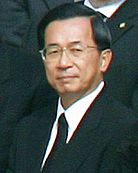Taiwan legislative election, 2008
|
|
|||||||||||||||||||||||||||||||||||||||||||||
|
|||||||||||||||||||||||||||||||||||||||||||||
|
|||||||||||||||||||||||||||||||||||||||||||||
|
|
|||||||||||||||||||||||||||||||||||||||||||||
| Election results:
Kuomintang
DPP
Non-Partisan Solidarity Union
Independent
|
|||||||||||||||||||||||||||||||||||||||||||||
|
|||||||||||||||||||||||||||||||||||||||||||||
The 7th Legislative elections were held on January 12, 2008 in Taiwan. The results gave the Kuomintang (KMT) and the Pan-Blue Coalition a supermajority (86 of the 113 seats) in the legislature, handing a heavy defeat to then-President Chen Shui-bian's Democratic Progressive Party, which won the remaining 27 seats only. The junior partner in the Pan-Green Coalition, the Taiwan Solidarity Union, won no seats.
These elections elected the first set of legislators to serve a longer four-year term in the Legislative Yuan, after an amendment in the Constitution in 2005, which intended to synchronize the legislative and presidential elections and reduce the size of the Legislative Yuan by half (see Taiwan National Assembly election, 2005). Two transitional justice referendums, both of which failed to pass due to low turnout, were held at the same time.
For the first time in the history of Taiwan, most members of the Legislative Yuan were to be elected from single-member districts: 73 of the 113 members were chosen in such districts by the plurality voting system (first-past-the-post). Parallel to the single member constituencies, 34 seats under an Additional Member System were elected in one national district by party-list proportional representation. For these seats, only political parties whose votes exceed a five percent threshold were eligible for the allocation. Six further seats were reserved for Taiwanese aborigines. Therefore, each elector had two ballots under parallel voting.
...
Wikipedia



